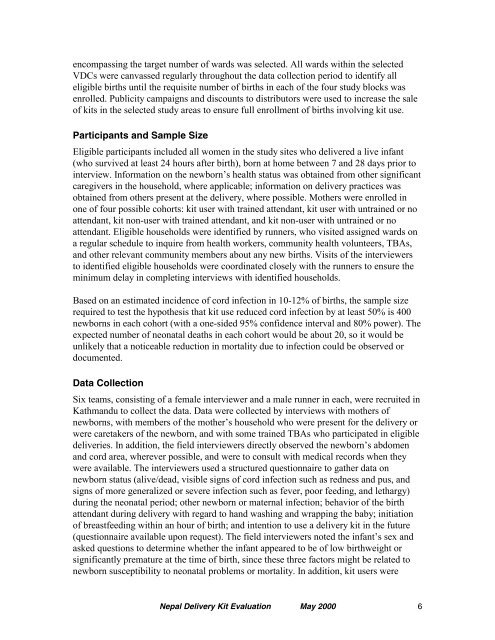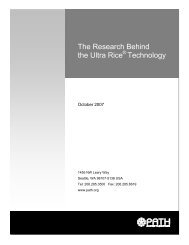Nepal Clean Home Delivery Kit: Evaluation of the Health Impact - Path
Nepal Clean Home Delivery Kit: Evaluation of the Health Impact - Path
Nepal Clean Home Delivery Kit: Evaluation of the Health Impact - Path
You also want an ePaper? Increase the reach of your titles
YUMPU automatically turns print PDFs into web optimized ePapers that Google loves.
encompassing <strong>the</strong> target number <strong>of</strong> wards was selected. All wards within <strong>the</strong> selected<br />
VDCs were canvassed regularly throughout <strong>the</strong> data collection period to identify all<br />
eligible births until <strong>the</strong> requisite number <strong>of</strong> births in each <strong>of</strong> <strong>the</strong> four study blocks was<br />
enrolled. Publicity campaigns and discounts to distributors were used to increase <strong>the</strong> sale<br />
<strong>of</strong> kits in <strong>the</strong> selected study areas to ensure full enrollment <strong>of</strong> births involving kit use.<br />
Participants and Sample Size<br />
Eligible participants included all women in <strong>the</strong> study sites who delivered a live infant<br />
(who survived at least 24 hours after birth), born at home between 7 and 28 days prior to<br />
interview. Information on <strong>the</strong> newborn’s health status was obtained from o<strong>the</strong>r significant<br />
caregivers in <strong>the</strong> household, where applicable; information on delivery practices was<br />
obtained from o<strong>the</strong>rs present at <strong>the</strong> delivery, where possible. Mo<strong>the</strong>rs were enrolled in<br />
one <strong>of</strong> four possible cohorts: kit user with trained attendant, kit user with untrained or no<br />
attendant, kit non-user with trained attendant, and kit non-user with untrained or no<br />
attendant. Eligible households were identified by runners, who visited assigned wards on<br />
a regular schedule to inquire from health workers, community health volunteers, TBAs,<br />
and o<strong>the</strong>r relevant community members about any new births. Visits <strong>of</strong> <strong>the</strong> interviewers<br />
to identified eligible households were coordinated closely with <strong>the</strong> runners to ensure <strong>the</strong><br />
minimum delay in completing interviews with identified households.<br />
Based on an estimated incidence <strong>of</strong> cord infection in 10-12% <strong>of</strong> births, <strong>the</strong> sample size<br />
required to test <strong>the</strong> hypo<strong>the</strong>sis that kit use reduced cord infection by at least 50% is 400<br />
newborns in each cohort (with a one-sided 95% confidence interval and 80% power). The<br />
expected number <strong>of</strong> neonatal deaths in each cohort would be about 20, so it would be<br />
unlikely that a noticeable reduction in mortality due to infection could be observed or<br />
documented.<br />
Data Collection<br />
Six teams, consisting <strong>of</strong> a female interviewer and a male runner in each, were recruited in<br />
Kathmandu to collect <strong>the</strong> data. Data were collected by interviews with mo<strong>the</strong>rs <strong>of</strong><br />
newborns, with members <strong>of</strong> <strong>the</strong> mo<strong>the</strong>r’s household who were present for <strong>the</strong> delivery or<br />
were caretakers <strong>of</strong> <strong>the</strong> newborn, and with some trained TBAs who participated in eligible<br />
deliveries. In addition, <strong>the</strong> field interviewers directly observed <strong>the</strong> newborn’s abdomen<br />
and cord area, wherever possible, and were to consult with medical records when <strong>the</strong>y<br />
were available. The interviewers used a structured questionnaire to ga<strong>the</strong>r data on<br />
newborn status (alive/dead, visible signs <strong>of</strong> cord infection such as redness and pus, and<br />
signs <strong>of</strong> more generalized or severe infection such as fever, poor feeding, and lethargy)<br />
during <strong>the</strong> neonatal period; o<strong>the</strong>r newborn or maternal infection; behavior <strong>of</strong> <strong>the</strong> birth<br />
attendant during delivery with regard to hand washing and wrapping <strong>the</strong> baby; initiation<br />
<strong>of</strong> breastfeeding within an hour <strong>of</strong> birth; and intention to use a delivery kit in <strong>the</strong> future<br />
(questionnaire available upon request). The field interviewers noted <strong>the</strong> infant’s sex and<br />
asked questions to determine whe<strong>the</strong>r <strong>the</strong> infant appeared to be <strong>of</strong> low birthweight or<br />
significantly premature at <strong>the</strong> time <strong>of</strong> birth, since <strong>the</strong>se three factors might be related to<br />
newborn susceptibility to neonatal problems or mortality. In addition, kit users were<br />
<strong>Nepal</strong> <strong>Delivery</strong> <strong>Kit</strong> <strong>Evaluation</strong> May 2000 6
















